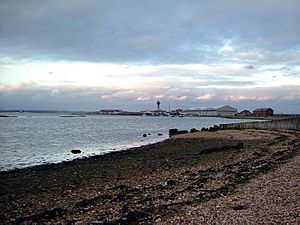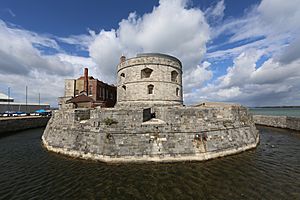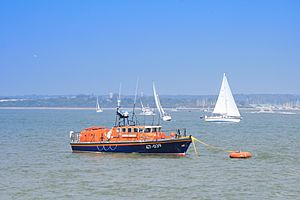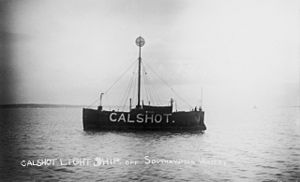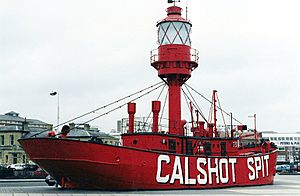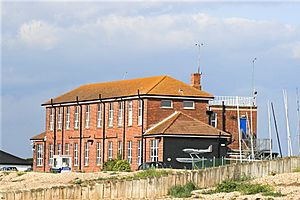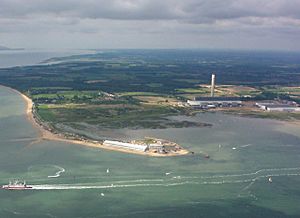Calshot Spit facts for kids
Calshot Spit is a long, narrow strip of land. It's about one mile (1.6 km) long. This land is made of sand and small stones. You can find it near the village of Calshot in southern England. It sits at the entrance to Southampton Water.
At the very end of this land strip, you'll find some interesting places. There's Calshot Castle, built by King Henry VIII. There's also a RNLI lifeboat station. This is where brave volunteers help people at sea. You'll also see an NCI station, which watches over the coast. There are also several slipways and a former Royal Air Force base for flying boats. Today, this area is home to the Calshot Activities Centre.
Contents
History of Calshot Spit
Calshot Castle's Role
Calshot Castle is a round stone building. It was built in 1539. The castle had large guns. Its main job was to protect the important harbour at Southampton. It stopped attacks from ships coming from France or Spain. These ships would sail through the English Channel and the Solent.
How the Spit Grew
For many years, the spit was quite low. Parts of it would often go underwater when the tide was high. This changed in 1703. A very big storm, called the Great Storm of 1703, hit the area. This storm washed a lot of stones onto the spit. This made it a much bigger and stronger piece of land.
Calshot Air Station
Calshot Naval Air Station started in 1913. It was a great spot for flying boats. The water here is calm and safe. Land on three sides of Southampton Water protects it. The Isle of Wight, a few miles away, protects the fourth side.
In 1916, they built a small railway. This railway helped move building materials. It ran from Eaglehurst camp to the north pier. In 1919, the air force took over the railway.
The Schneider Trophy
Calshot was famous for air races. In 1929 and 1931, it hosted the Schneider Trophy. This was a big international race for seaplanes.
End of the Railway
The railway stopped working after World War Two. The wagons were too old and unsafe. One engine from this railway still exists. It's called Douglas and runs on the Talyllyn Railway.
Modern Calshot
In the early 1960s, the spit became a civilian area. Today, it's home to the Calshot Lifeboat Station. This station is run by the RNLI. You'll also see many yachts here. The National Coastwatch Institution also has a station.
The old aircraft hangars are now part of the Calshot Activities Centre. Inside, you can find indoor climbing walls. There are also artificial ski slopes and a velodrome for cycling. In 2005, new public toilets were built. Their design was inspired by the beach huts on the spit.
Guiding Ships
Calshot Spit can be a danger for ships. It's right at the entrance to Southampton Water. To help ships, there's a special light float. This float guides vessels safely.
Before the light float, there was a Trinity House lightvessel. This was a special ship with a light. It was anchored off the spit. This lightship, called LV 78, was built in 1914. It stopped working in 1978. For a while, it was a display at the Ocean Village marina in Southampton.
Lightship's Journey
In 2010, LV 78 moved to Trafalgar dock. There were plans to display it at a new attraction. These plans didn't happen. In 2019, the ship moved again. It went to the Solent Sky museum. It will become part of the museum's cafe.
Another lightship, LV 50, was also once at Calshot. The Royal Northumberland Yacht Club bought it. It is still their club ship today.
Ferry Connections
Sometimes, people from RAF Calshot would travel by boat. They would get on or off Red Funnel ferries. These ferries were passing by the spit.
Plants and Wildlife
Protecting Plants
In the past, Calshot Spit was a military base. This actually helped protect the local plants. Building car parks and beach huts changed things. It also reduced the types of plants growing there.
Sea Kale
However, a plant called Crambe maritima (sea kale) still grows on the spit. In the 1800s, people would collect this plant. They would then sell it in Southampton.
Images for kids


